Are you on the fence about implementing feature voting for your product?
You’re not alone.
Many product managers question whether feature voting is truly effective or just a pointless exercise.
We’ve been using feature voting ourselves successfully for over 7 years and we’re going to show you what’s worked for us, pitfalls to watch out for, and things to look for when choosing a feature voting tool.
Whether you’re drowning in user feedback, struggling to prioritize features, or just want to give your users a stronger voice, this guide has you covered.
- Why you should offer feature voting to your users?
- Top 4 benefits of feature voting
- Who should use feature voting (and who shouldn’t)
- Common mistakes to avoid with feature voting
- 5 tips for doing feature voting right
- Common objections to feature voting
- The only 5 feature voting tools to consider (19 analyzed)
- Feature Upvote
- Feature Voting FAQ
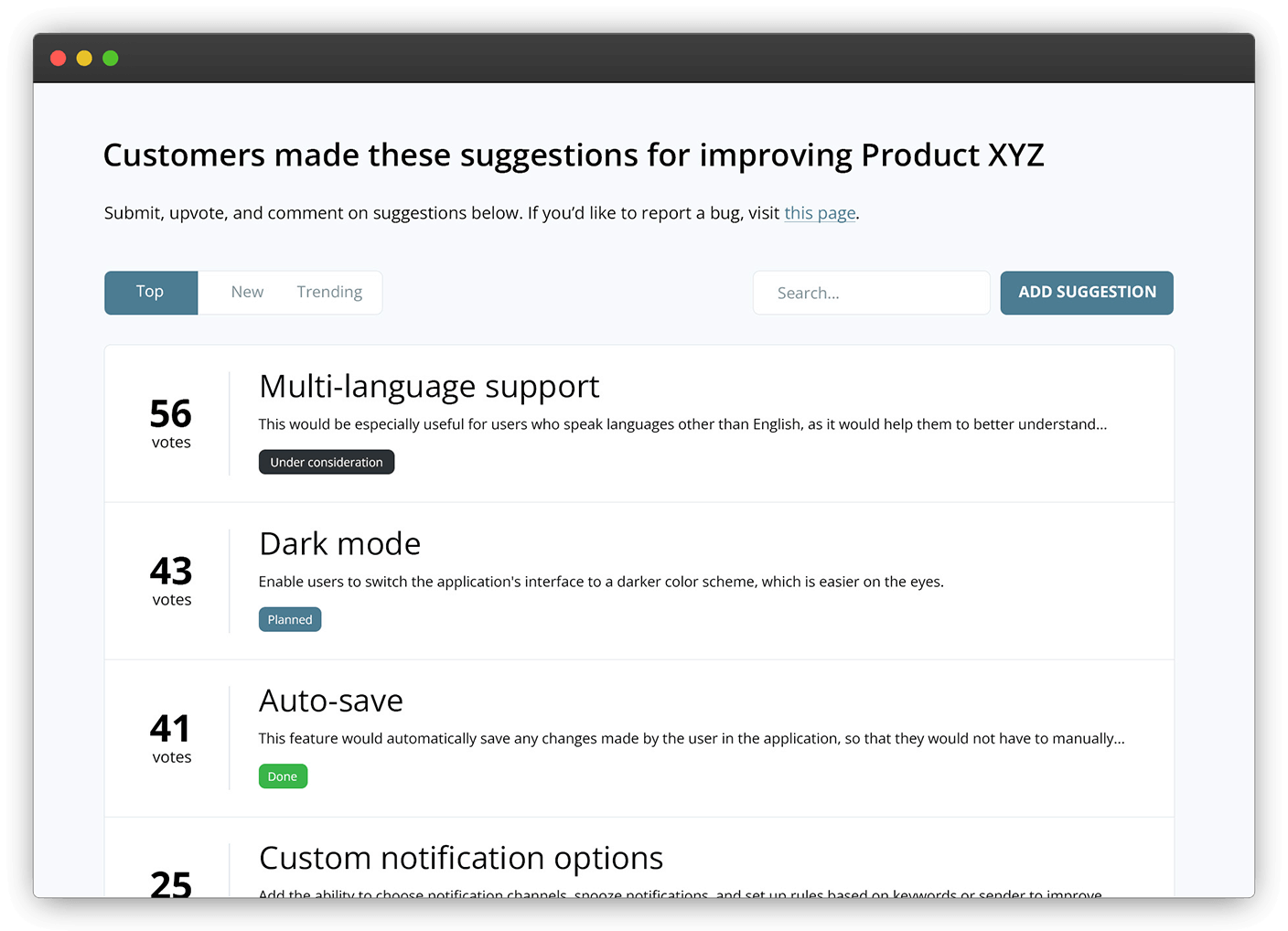
Why you should offer feature voting to your users?
Picture this: your users are brimming with ideas to improve your product, but their voices are getting lost in a sea of support tickets, emails, and social media noise.
Feature voting is your lifeline.
By giving your users a dedicated platform to submit, discuss, and upvote feature ideas, you’re not just collecting feedback — you’re building a community around your product.
Your users feel heard, valued, and invested in your success.
In summary, feature voting helps you:
- Streamline your feedback collection and save countless hours.
- Surface the most demanded features, so you can prioritize with confidence.
- Close the loop by notifying users when the suggestions they voted up are implemented.
- Build trust by showing users their input matters.
- Harness the power of the crowd to let users support each other.
Your users get a direct line to influence your product roadmap, and you get clear, actionable data to guide your decisions.
Top 4 benefits of feature voting
1. Streamline feedback collection
As your product grows, so does the volume of feature requests landing in your inbox, support queue, social media mentions, and casual chats.
Keeping track of all this feedback scattered across multiple channels is a massive time sink.
That’s where a feature voting board helps.
It funnels all those requests into one centralized place, making it effortless for your users to submit and upvote ideas.
Imagine all your feature requests neatly organized, tagged, and prioritized by popularity. That’s the power of a voting board.
Of course, you’ll still get feature requests through other channels. But with a voting board, you have a clear process to consolidate that feedback.
The beauty of a streamlined feedback collection process is that it scales with your growth. Whether you’re managing feedback for 100 users or 10,000, a voting board keeps things organized and under control.
2. Uncover the most popular feature requests
As a product manager, your job is to deliver maximum value to your users and your business.
Feature voting brings data to that job.
The most upvoted ideas rise to the top, giving you a clear signal of what’s truly important to your user base.
No more relying on the loudest voices or the latest customer conversation to sway your priorities.
But feature voting isn’t just about identifying the most popular ideas — it’s also a powerful tool for validating your own hypotheses.
Have a brilliant feature idea that you think will be a game-changer? Put it to the test on your voting board and let your users weigh in.
This data-driven approach to prioritization is especially crucial when resources are tight. You can’t afford to chase after every shiny idea or get sidetracked by vocal minorities.
Of course, popularity isn’t the only factor to consider when prioritizing. You still need to weigh each feature against your strategic goals, cost to implement, and other criteria.
But feature voting provides a vital piece of the puzzle — a quantitative measure of user demand that you ignore at your peril.
3. Manage expectations by giving your users full visibility
Transparency is the foundation of trust in any relationship. And with no visibility into the process, users are left in the dark, wondering if their voice even matters.
A public feature voting board is your megaphone to show users that you’re not only listening but acting on their input.
Imagine the delight of a user who suggests a feature, then watches it climb the ranks as other users upvote it.
But transparency isn’t just about celebrating the wins — it’s also about navigating the tough calls. Use your voting board to explain why certain ideas are infeasible or low priority.
This open dialogue builds a sense of partnership between you and your users.
Over time, this transparency becomes a self-regulating mechanism.
Users can see which features are getting traction and adjust their expectations accordingly.
If a request has been languishing on the backlog for months with few upvotes, they’ll understand that it’s not likely to happen anytime soon.
This frees you up from having to constantly manage expectations on an individual basis.
4. Empower users to respond to feedback while you sleep
Here’s a little-known secret about feature voting boards: they don’t just collect feedback — they spark conversations.
This is the power of crowdsourcing in action. Users become not just consumers of your product, but active participants in shaping its future.
When users see that their peers are actively engaged with your product and that their ideas are sparking lively discussions, they feel like they’re part of something bigger.
Too good to be true?
Here’s a real-world example.
When we made our feedback board public 7 years ago, we were surprised to see customers engaging with each other and essentially moderating the board on our behalf.
We’ve seen users comment on a feature request to let the author know (and us) that the feature had already been submitted and to encourage them to go and upvote the existing request.
This considerably reduced the amount of time we spent responding to customer requests.
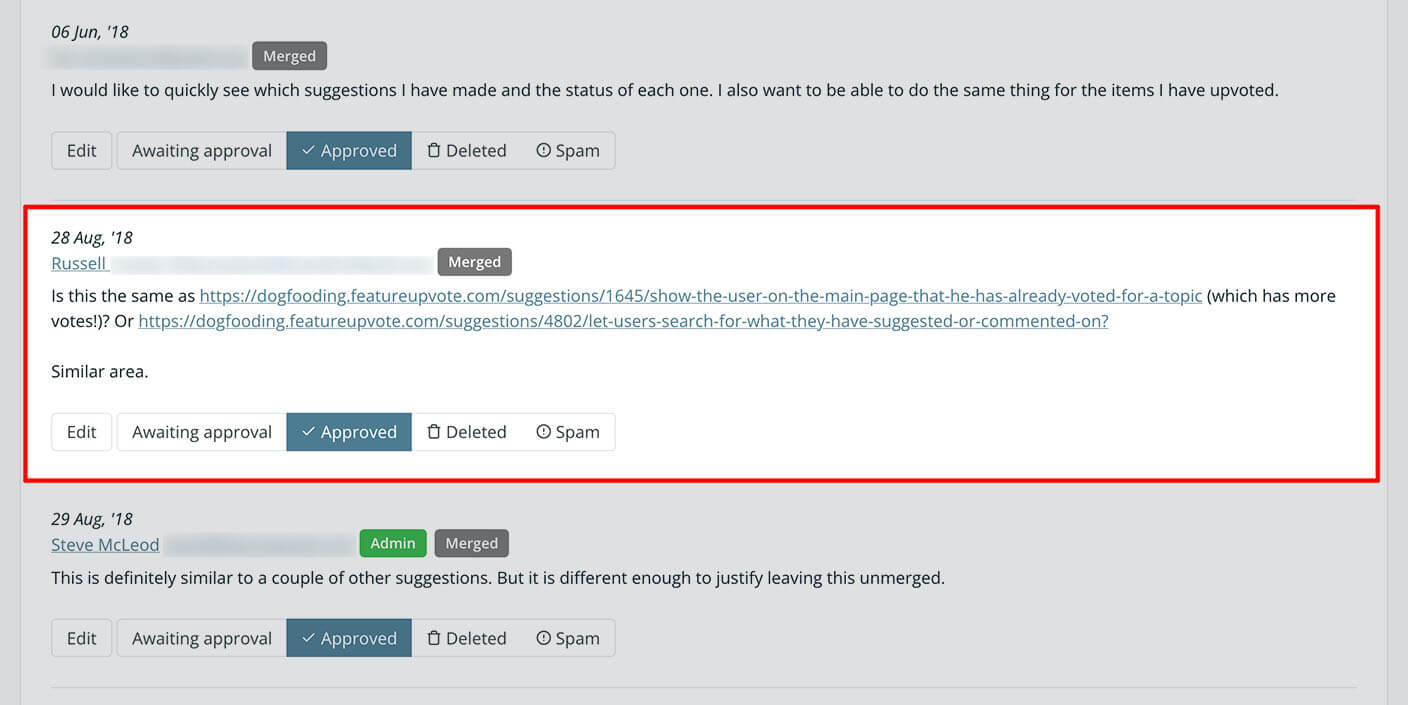
Who should use feature voting (and who shouldn’t)
Feature voting isn’t for every company, nor is it for every product.
Use feature voting if:
✅ You’re drowning in feedback. You’re collecting feature requests in a spreadsheet or Jira and are struggling to track and make sense of the feedback you’re getting.
✅ You have no way to evaluate the reach and importance of a feature—it’s mostly guesswork. You need a system for knowing which feature requests you’re getting more often so you can make quantified product decisions.
✅ Your roadmap is shaped around whatever senior management is pushing for at any given time. Your users’ voice and needs are lost in the process.
Don’t use feature voting if:
❌ You’re developing a new product and haven’t yet hit product market fit. Because you’re likely to pivot, the suggestions you’ll get won’t be relevant or helpful.
❌ You don’t want competitors to see your feedback board. That’s a personal choice that has a lot to do with the industry you’re in and the way you run the business. We keep our board public – here’s why.
Overwhelmed with customer feedback? Try Feature Upvote.
We make easy-to-use feedback boards that let your customers submit and upvote feature requests – all in one place.
Common mistakes to avoid with feature voting
As powerful as feature voting can be, it’s not a magic wand.
Implementing it successfully requires careful planning, clear communication, and ongoing commitment.
Many product teams jump in with the best intentions, only to see their voting boards languish from neglect or misuse.
To help you sidestep these pitfalls, let’s look at some of the most common mistakes companies make when starting with feature voting:
- Not consolidating feedback — If you introduce a voting board but continue to take feature requests through other channels without funneling them to the board, you’ll end up with a fragmented and incomplete picture of user demand.
- Letting the board become a graveyard — A voting board filled with stale, outdated requests is worse than no board at all. It sends the message that you’re not actively listening or taking action on user feedback.
- Treating upvotes as the sole prioritization metric — Upvotes are a valuable signal, but they shouldn’t be the only factor in your prioritization decisions.
- Not closing the loop with users — If users take the time to submit and upvote requests, but never hear back from you about the outcome, they’ll quickly lose faith in the process.
- Implementing a board without a clear process — A voting board without clear guidelines around how to submit requests, how they’ll be evaluated, and what happens next is a recipe for frustration on all sides.
- Choosing the wrong tool for the job — Not all voting boards are created equal. Choosing a tool that doesn’t fit your needs or integrate with your existing workflow can lead to low adoption and wasted effort.
By being aware of these common pitfalls, you can proactively plan to avoid them as you roll out your feature voting initiative.
Remember, the goal isn’t just to collect feedback, but to build a sustainable process that empowers your users and informs your product decisions for the long haul.
5 tips for doing feature voting right
Collect all of your feedback in one place
You must consolidate all of the feedback you receive in one place to help track and quantify the users’ needs.
That means pointing the contributor to your board or adding their suggestion on their behalf.
Many feature voting tools offer integrations that make it easy to move suggestions from and to different tools like Slack, Jira and Zendesk and reduce the chance of feature requests falling through the cracks.
Related: Feature Upvote integrations
Delete old requests regularly
Something that was suggested 2 years ago shouldn’t still be “under consideration”.
Either it gains traction or it doesn’t.
And if it doesn’t, then it should be archived.
Occasionally go through old requests and delete things that haven’t received many votes.
If it’s something your users really need, someone will go in and add it back to the board.
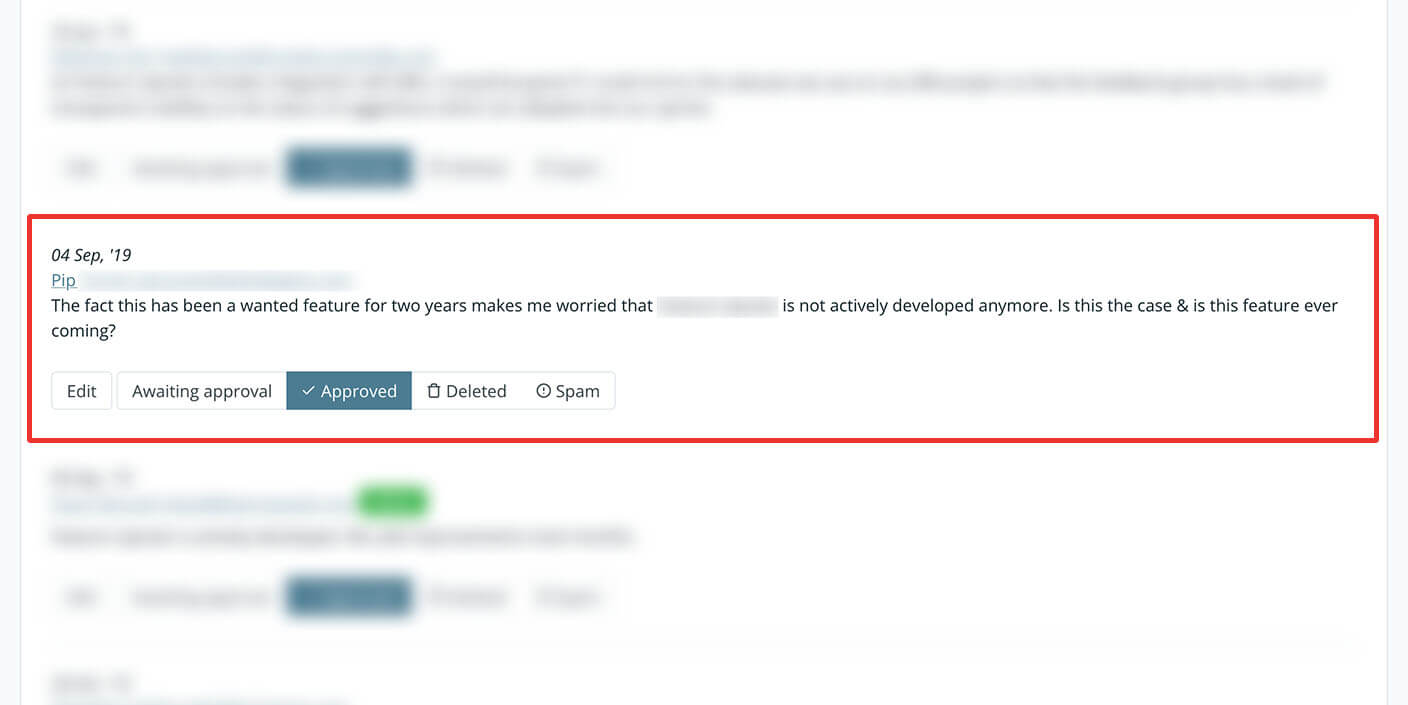
Manage expectations
As users submit product ideas, you must acknowledge and address their feedback.
Use comments and status updates to let users know when their suggestion has been considered, added to the roadmap, or released.
Indicate why a feature will not be implemented using a status such as “Not planned” or “Won’t do”.
By closing the feedback loop, you make your users feel heard and encourage them to continue contributing product improvements and feature ideas.
Combine votes with other criteria to inform your roadmap
Popularity is only one dimension of feature prioritisation.
Weigh it up against the vision for your product, how much work building the feature involves, how much maintenance work it is going to require, etc.
Complement that with customer interviews, surveys, and other customer feedback tools.
Find a system that works for you
Once you’ve chosen the right feature voting tool, you need to decide how you’re going to collect feedback.
There are many ways you can go about this and you should feel free to choose the way that works for you.
It wouldn’t make sense for a video game company to collect feedback the same way a marina management platform would, would it?
For example, you could collect feedback in 2 phases: first suggestions, then votes.
Or you could open your board to beta testers only (using an access list) before opening it to the general public.
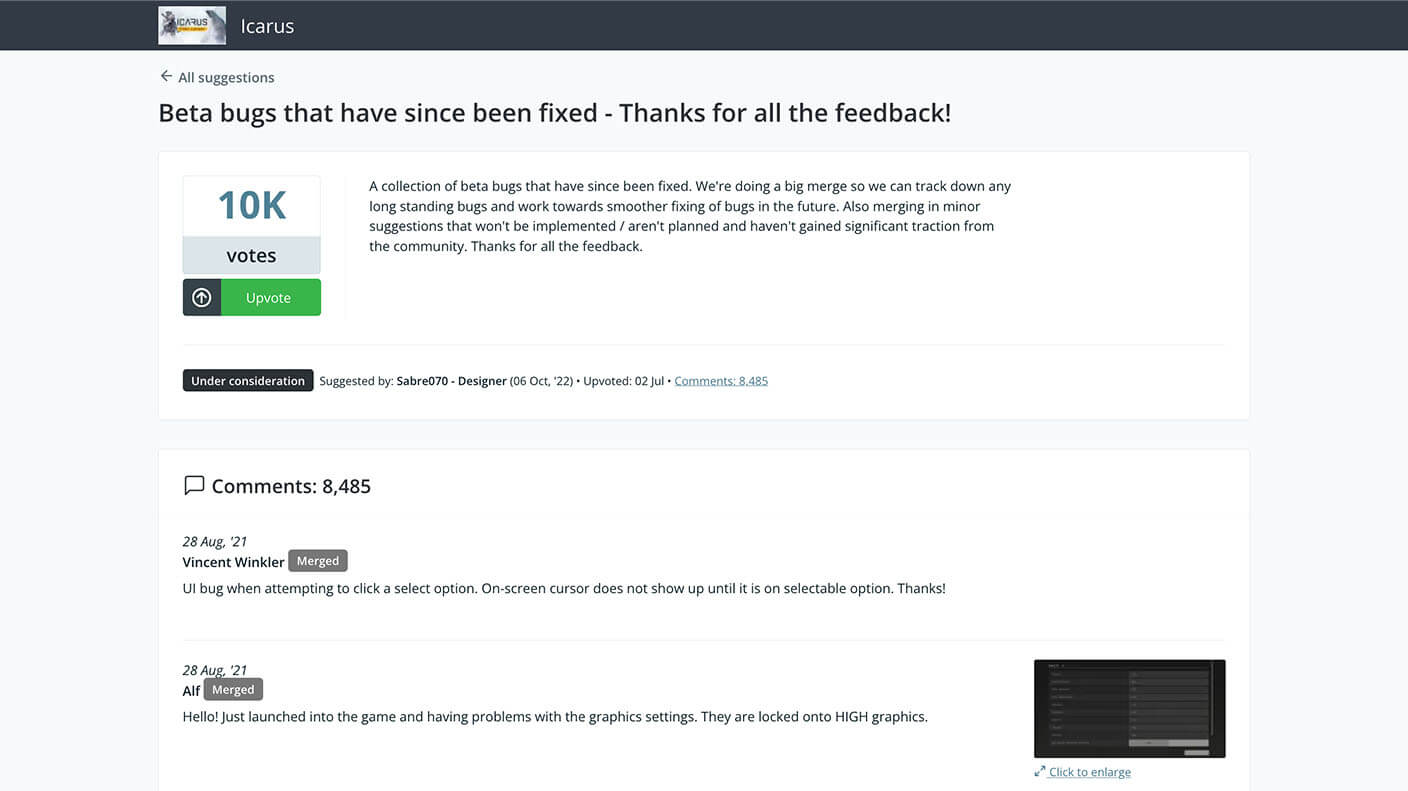
Common objections to feature voting
“Feature voting is subject to bias. People will upvote what’s already popular.”
Yes, requests that are already popular are likely to get more votes.
Unintentional bias is a problem not just with feature voting boards, but with any voting system. Even in national electoral systems, there is evidence that candidates listed first on the ballot get more votes than they otherwise would.
And yet, people don’t give up on national elections because of this issue.
Here’s how we see it:
Firstly, most people visit your board to request a specific feature that they want. They’re not going there just to browse. They will use the search bar to look for their suggestion, then either upvote it or add it themselves if it’s not there yet.
Secondly, your feature request board is not a binding vote where the item with the most votes wins. It is simply one input into your decision-making system.
Remember, you don’t have to have a perfect system, you just have to have a system. Feature voting, even with unintended biases, is better than merely guessing what features your users want.
“Customers don’t know what they want.”
Too many times, I’ve heard the allegedly Henry Ford quote, “If I had asked people what they wanted, they would have said faster horses.”
There’s no evidence Henry Ford ever said this, or even thought it.
However there is some truth in the non-quote. Users are much better at reporting problems than they are with coming up with solutions.
The goal of a feature voting board is not to innovate; the goal is to identify what issues people have with your product as it currently is.
Users rarely come up with innovative, groundbreaking feature ideas. They will suggest iterative improvements, like adding PDF export when you already offer CSV export. Or that you make it possible to change the layout of an element that’s already in the interface.
If you’re looking for novel feature ideas, these come from within your product team.
“Feature voting is too simplistic. It ignores things like market potential, confidence, effort, and ROI.”
Feature voting does not aim to reduce product management to building the most popular features. Votes are only supposed to be one input into your decision-making process.
You should not base your decision solely on what’s most popular. But it is an important input.
For example, consider two feature requests; both have 100 votes, but one can be done in one afternoon and the other in one month. Will you prioritise them the same way?
But if the one that can be done in afternoon has just one vote? You should probably ignore it, and work on the harder, more popular one.
Feature voting answers one question: how many users will this feature help relative to other ideas?
The only 5 feature voting tools to consider (19 analyzed)
How to choose the right feature voting tool?
Finding the right feature voting app is more complex than it seems. They kind of look the same at first, but there are critical differences you need to understand before making a choice.
For that reason, you should consider several key factors:
- Ease of upvoting: Tools that remove friction, such as allowing users to interact without logging in or creating an account, can lead to increased participation and more valuable data.
- Efficient suggestion management: Effective feature request management requires tools with robust moderation features, the ability to merge and split suggestions, a comprehensive dashboard, tagging, and the ability to highlight trending suggestions.
- Pricing structure: Choose a pricing model that is affordable, predictable, and sustainable. You don’t want bad surprises due to hidden fees, activity spikes, or ongoing increase in contributors.
- Private boards: If you plan to use the tool internally, ensure the software offers options for Single sign-on (SSO) or password protection.
- Integrations: Select a tool that integrates seamlessly with your existing toolkit, such as Slack, Zendesk, Jira, and Discord, to enhance your workflow. Bonus point if it also allows you to export data into the tools you already use to analyze data.
For example, if you start using a tool without the right data management features, you will end up with unusable data and won’t be able to make decisions on this data.
Be sure to consider these criteria before making your decision.
Why you shouldn’t consider survey tools for feature voting
During our research and analysis, we found out that other guides would list survey tools as alternatives for feature voting tools.
We think it’s wrong for the following reasons:
- It doesn’t solve the flood of requests. No moderation, merging and splitting of requests, splitting, discussions with other users, etc.
- It doesn’t help communication amongst teams. You can’t invite everyone to survey tools because it would be expensive and there wouldn’t be ways to communicate with each other.
- It doesn’t help with prioritization. You get the same requests over and over again from responses but no features to aggregate them together.
That’s why you won’t see tools like SurveySparrow, Survicate, Qualtrics, Qualaroo, Refiner, Saber Feedback, and other survey tools in our guide.
Why you shouldn’t consider product management tools for feature voting
Product management tools are usually able to handle feature voting.
But there’s a big problem that comes with them:
Feature voting boards are an afterthought of product management tools.
They attempt to be a suite of products, rather than just doing one thing really well.
The result is a lack of critical features. So you end up with pretty much the same 3 problems as using survey tools.
That’s why you won’t see tools like Productboard, Pendo, Jira, Usersnap, UserReport, or others in our guide.
We made an exception for Aha! Ideas because it can act as a standalone tool and has enough capabilities to be worthy of being included.
Reasons we shortlisted only 5 tools over the 19 we analyzed
Our goal is to give you an easy choice. If we were to put 19 tools in the guide, you would end up more confused.
It doesn’t mean we didn’t analyze all the alternatives.
We have.
And many lack fundamental features, have clunky UX, or are not actively maintained.
Others are too immature yet.
But our guide gives you everything you need to make your selection easy.
Our top 5 picks
Based on the criteria we just listed, here are the 5 feature voting tools that made our list:
- Feature Upvote
- UserVoice
- Canny
- Aha! Ideas
- Trello
There’s no “best” choice, we’re not claiming to be the best. We’re providing you with clear information so you can make your choice easily.
| Feature Upvote | UserVoice | Canny | Aha! Ideas | Trello | |
|---|---|---|---|---|---|
| Pricing | Starts at $49/mo | Starts at $699/mo | Starts at $79/mo | Starts at $117/mo | Starts at $5/user/mo |
| Free trial available? | 30-day free trial | 14-day free trial | 14-day free trial | 30-day free trial | Trello has a free version |
| Biggest pro | The simplest & easiest to use. | A lot of features dedicated to enterprise customers. | Prioritization scoring with roadmaps. | It’s very well integrated into the Aha! product management suite. | The most affordable solution. |
| Biggest con | Only does feature request boards. | The price tag is difficult to justify. | Many key features are limited to the more expensive plans. | The pricing is per user which makes private boards really expensive. | A lot of key features are missing. |
Feature Upvote
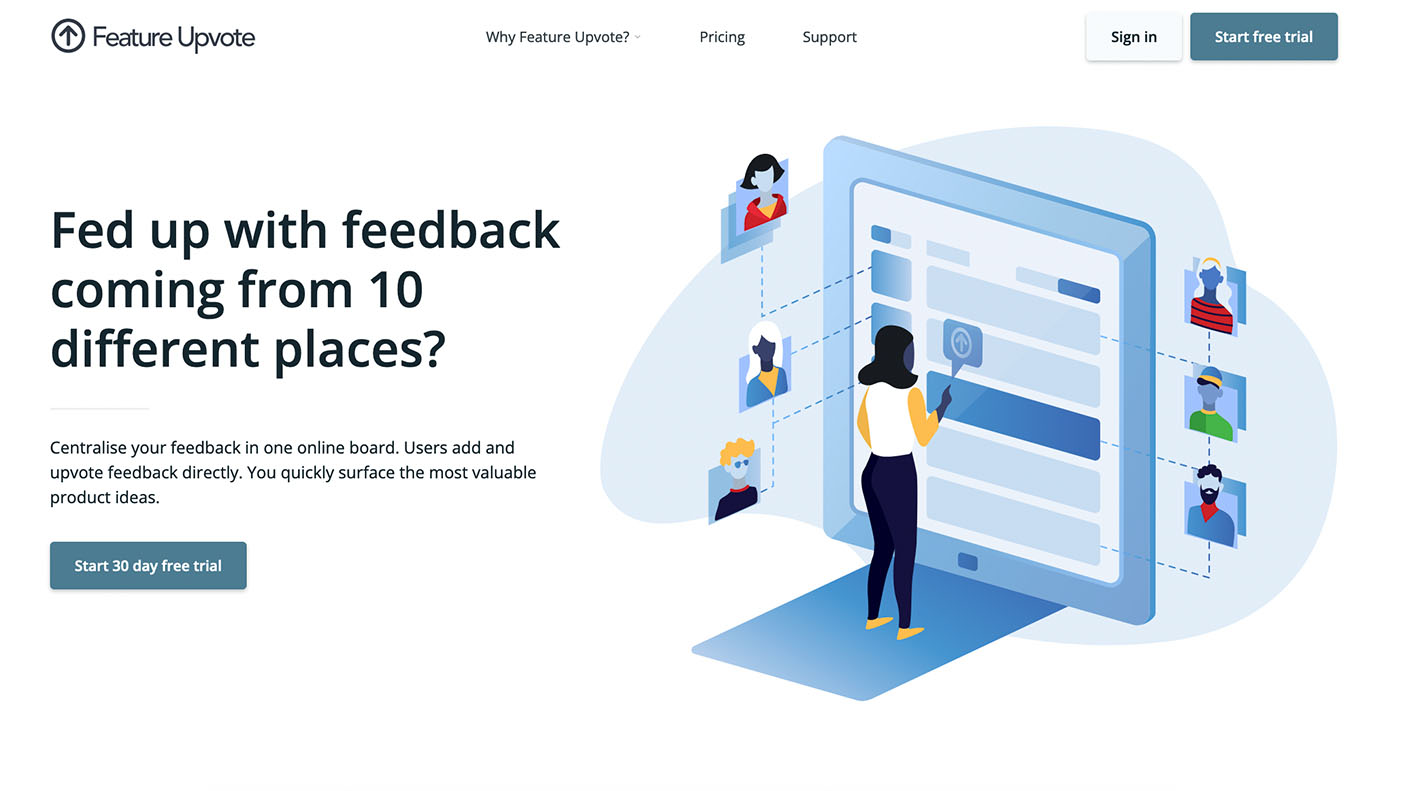
Simplicity and ease of use are at the core of Feature Upvote.
A lot of feedback management tools on the market are stuffed with features and offer a level of complexity most SaaS companies won’t need.
Feature Upvote’s platform is clean, intuitive, and focused on one thing: providing product managers with a centralized hub to view, prioritize, and manage their users’ requests.
A big plus of Feature Upvote is that contributors can easily submit, comment, and vote for feature requests without having to log in or create an account.
As the moderator, you have access to a simple dashboard to quickly see new suggestions, actions to take, and customize the feedback boards.
You can also add your comments to each suggestion to take part in the conversation and share updates on the most anticipated features.
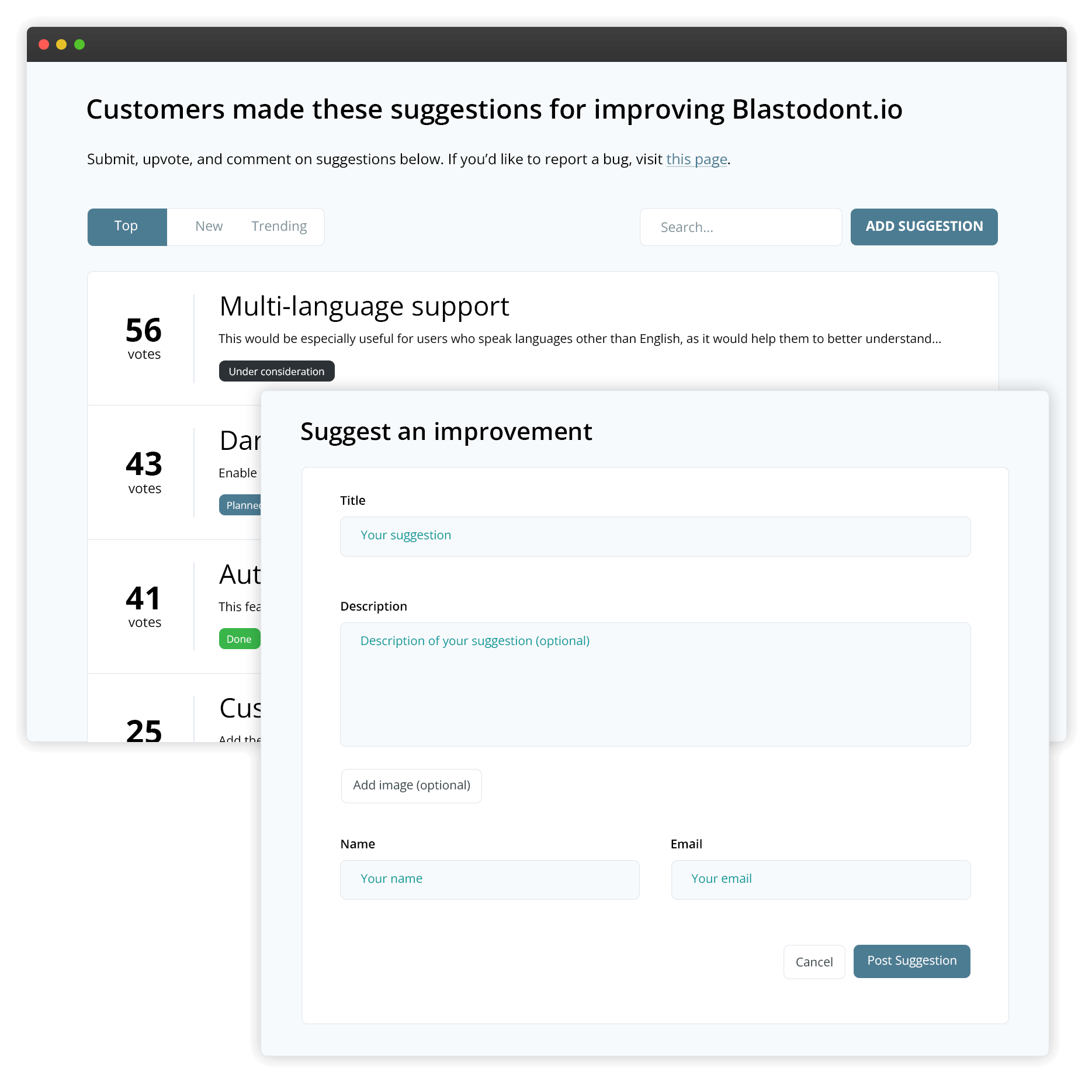
Feature Upvote gives you the ability to run private SSO or password-protected boards. This is particularly useful if you want to collect suggestions from your team or add and vote for feature requests on behalf of your customers.
Lastly, the pricing structure works great for small and medium-sized businesses. There’s a fixed price per board with unlimited team members, contributors, and all features included from the very first board.
“Competing products are much more complex and much more expensive. For the functionality we’re looking for – a simple feedback community – the features we get are actually better than I expected and at a price that we can afford.”
Heather Paunet, Untangle’s VP of Product Management
Pros
- All features and integrations included as standard
- No login required for contributors giving feedback
- Voting on behalf of users
- On-brand boards with custom domains and CSS
- Powerful organization via tagging, searching, merging similar ideas
- One-click status updates to keep customers in the loop
- Private boards for employee/stakeholder collaboration
- Quick setup (no sales call)
- Transparent and affordable pricing
- Simple responsive user interface
- Integrates with Trello, Slack, Jira, Microsoft Teams, Discord and a plethora of others through Zapier
- Feature request boards available in 15+ languages
Cons
- No support chat or instant messaging
- Feedback board only, not a whole product management system
Pricing
Starts at $49/mo per board.
If you need Single sign-on (SSO), custom CSS, or more integrations (Microsoft Teams, Jira, Zapier), the price is $99/month per board.
Both options include unlimited team members and contributors, unlike many of the other tools.
Bottom line
Feature Upvote is ideal for small and medium businesses looking for a lean feature request solution that doesn’t break the bank.
Feature voting tool: Feature Upvote
Want to try a feature voting tool that checks all the boxes and doesn’t break the bank? Try Feature Upvote. We offer a 30-day trial with all features included. Set up a board in seconds and explore the functionality.
No credit card required. All features included.
Feature Voting FAQ
What is feature voting?
Feature voting is a process where users can submit, discuss, and vote on ideas for new features or improvements to a product.
It allows companies to gather feedback, prioritize development efforts, and build features that users truly want.
How can I encourage users to participate in feature voting?
- Make your voting board easy to find and use
- Actively promote the board through in-app notifications, email, and social media
- Respond to user submissions and comments to show that you value their input
- Regularly update users on the status of popular feature requests
How often should I review and act on feature voting results?
The frequency of reviewing and acting on feature voting results depends on your development cycle and resources.
However, aim to review the board at least monthly, prioritize top requests, and provide regular status updates to keep users engaged and informed.
Can feature voting be used for internal product development?
Yes, feature voting can be a valuable tool for internal product development.
It allows teams to collaboratively brainstorm, prioritize, and align on feature ideas.
Internal voting boards can also help product managers understand the needs and pain points of different departments.
How can I integrate feature voting into my existing product development process?
- Define clear guidelines for how feature requests will be evaluated and prioritized
- Establish a regular cadence for reviewing and acting on voting results
- Use voting data as one of several inputs in your prioritization framework
- Communicate decisions and updates back to the feature voting board
- Celebrate launched features that originated from user suggestions
How do I keep my feature voting board organized and manageable over time?
- Regularly merge duplicate requests
- Close and archive requests that have been addressed or declined
- Use tags or categories to keep requests searchable and navigable
- Set up automation rules to handle common moderation tasks
- Enlist power users to help moderate and organize the board
